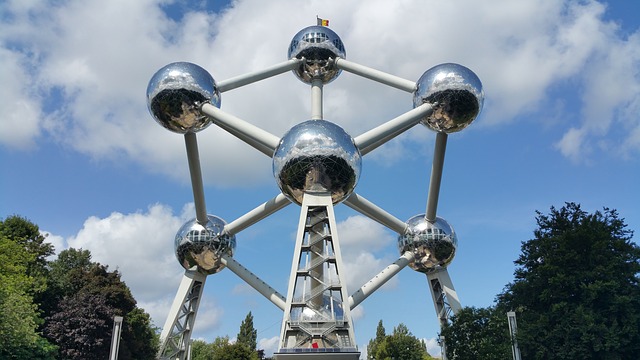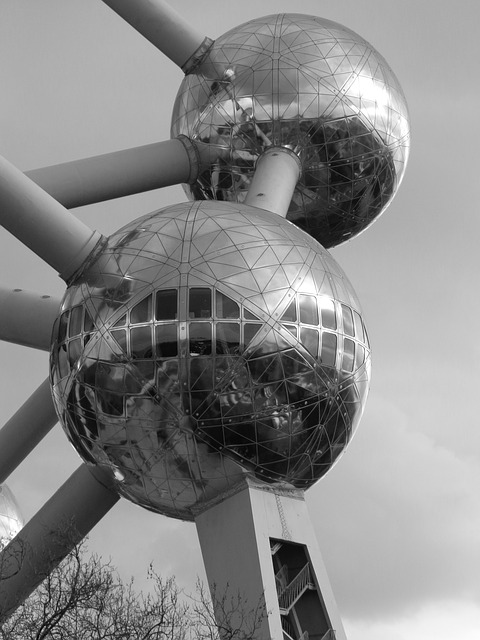Main author
Michael BrooksThe Atomium
The Atomium, in Brussels, Belgium, was the main pavilion and iconic image of the World Fair of 1958 (Expo 58). It is now a museum and tourist attraction. The building is 102 m (335 ft) tall, and consists of nine interconnected spheres, representing an elementary iron crystal enlarged 165 billion times.
The philosophy behind the design, by the engineer Andre Waterkeyn, was that it would symbolise a positive and democratic faith in technological progress and offer an optimistic vision of a modern scientific future.
The Atomium is made up of 8 spheres at the apexes of the structure, and 1 in the centre, each 18 m (59 ft) in diameter. The 9 spheres are connected by 20 tubes, each 29 m long. The whole composition rests on 3 supporting structures.
Stairs, escalators and a lift allow access to five of the spheres which are open to the public, and contain exhibition halls. The highest sphere contains a restaurant with panoramic views of Brussels.
In 2004, renovation works began, and lasted nearly 3 years. These works included replacing the aluminium cladding with stainless steel. The aluminium was sold as souvenirs to help pay for the renovation.
Despite originally being intended as a temporary structure, its popularity and success led to it becoming a permanent landmark and a national symbol of Belgium.
[edit] Related articles on Designing Buildings Wiki
- Ark Encounter, Kentucky.
- Blur Building.
- Building of the week series.
- Cube Houses.
- Dali Theatre and Museum.
- Dunmore Pineapple.
- Lotus Temple.
- Robot Building, Bangkok.
- Sage Gateshead.
- The Big Basket.
- Theme Building, LAX
- Titanic Belfast.
- Unusual building design of the week.
[edit] External references
Featured articles and news
Latest Build UK Building Safety Regime explainer published
Key elements in one short, now updated document.
UKGBC launch the UK Climate Resilience Roadmap
First guidance of its kind on direct climate impacts for the built environment and how it can adapt.
CLC Health, Safety and Wellbeing Strategy 2025
Launched by the Minister for Industry to look at fatalities on site, improving mental health and other issues.
One of the most impressive Victorian architects. Book review.
Common Assessment Standard now with building safety
New CAS update now includes mandatory building safety questions.
RTPI leader to become new CIOB Chief Executive Officer
Dr Victoria Hills MRTPI, FICE to take over after Caroline Gumble’s departure.
Social and affordable housing, a long term plan for delivery
The “Delivering a Decade of Renewal for Social and Affordable Housing” strategy sets out future path.
A change to adoptive architecture
Effects of global weather warming on architectural detailing, material choice and human interaction.
The proposed publicly owned and backed subsidiary of Homes England, to facilitate new homes.
How big is the problem and what can we do to mitigate the effects?
Overheating guidance and tools for building designers
A number of cool guides to help with the heat.
The UK's Modern Industrial Strategy: A 10 year plan
Previous consultation criticism, current key elements and general support with some persisting reservations.
Building Safety Regulator reforms
New roles, new staff and a new fast track service pave the way for a single construction regulator.
Architectural Technologist CPDs and Communications
CIAT CPD… and how you can do it!
Cooling centres and cool spaces
Managing extreme heat in cities by directing the public to places for heat stress relief and water sources.
Winter gardens: A brief history and warm variations
Extending the season with glass in different forms and terms.
Restoring Great Yarmouth's Winter Gardens
Transforming one of the least sustainable constructions imaginable.

























